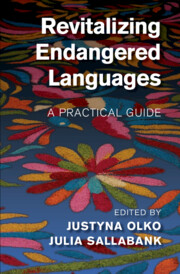Crossref Citations
This Book has been
cited by the following publications. This list is generated based on data provided by Crossref.
Saft, Scott
2021.
Language and Social Justice in Context.
p.
301.
Агранат, Татьяна Борисовна
2021.
PECULIARITIES OF LANGUAGE (NON) TRANSMISSION IN SIBERIAN SETO COMMUNITY.
Tomsk Journal of Linguistics and Anthropology,
p.
9.
Saft, Scott
2021.
Language and Social Justice in Context.
p.
1.
Scetti, Fabio
and
Salamino, Federica
2022.
Project VVV and the Issue of Revitalising Valoc’.
Adeptus,
Giles, Howie
2022.
Recent New Book Alerts, 2020-2022.
Journal of Language and Social Psychology,
Vol. 41,
Issue. 2,
p.
232.
2022.
Publications Received.
Language in Society,
Vol. 51,
Issue. 1,
p.
183.
Topping, Matthew W.
2022.
“Words That Open Your Heart”—Overcoming Social Barriers to Heritage Language Reclamation in Ishigaki City.
Languages,
Vol. 8,
Issue. 1,
p.
5.
Ávila Molina, Angélica María
2023.
Construcción participativa de recomendaciones para la enseñanza de la lectoescritura en la comunidad wounaan de Bogotá.
Forma y Función,
Vol. 36,
Issue. 2,
Grenoble, Lenore A
and
Osipov, Boris
2023.
The dynamics of bilingualism in language shift ecologies.
Linguistic Approaches to Bilingualism,
Vol. 13,
Issue. 1,
p.
1.
Echeverria, Begoña
and
Sparling, Heather
2024.
Heritage language revitalisation and music.
Journal of Multilingual and Multicultural Development,
Vol. 45,
Issue. 1,
p.
1.





